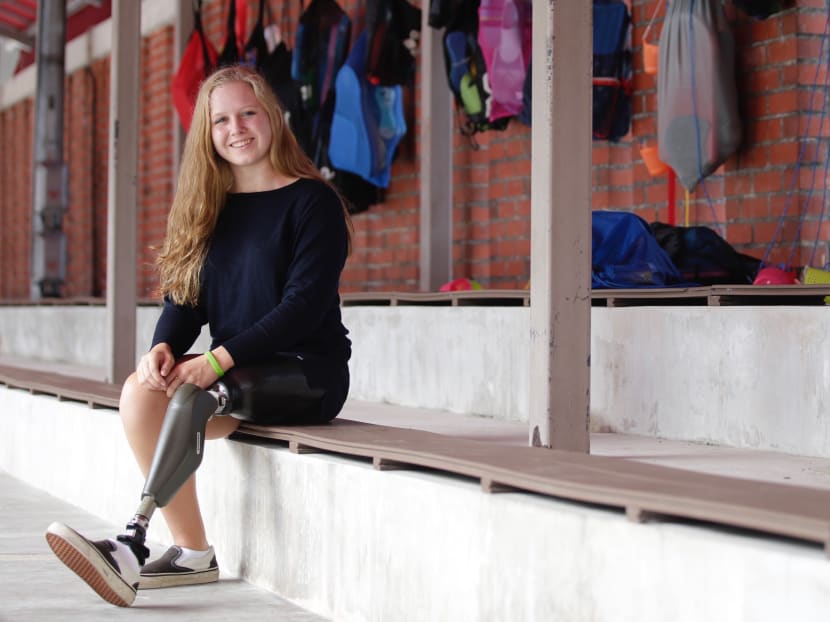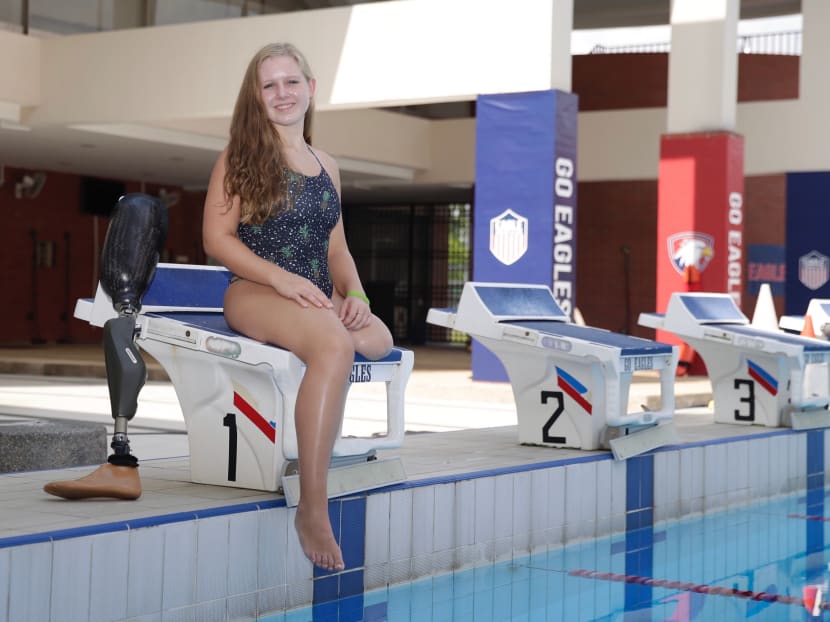Teen who lost a leg to sarcoma swims 400 laps to raise awareness of the ‘forgotten cancer’
SINGAPORE – Teenager Emma Oldager was only nine when she was told her left leg would be amputated. Diagnosed with sarcoma – a rare and aggressive form of cancer that arises from connective tissue cells such as bone, cartilage, nerves, muscle and fat cells – Emma’s cancer had spread so rapidly in her bone that completely removing the affected limb offered the best chance for survival.

Emma Oldager, 16, was only nine when she was first diagnosed with cancer and told her left leg would be amputated.
SINGAPORE – Teenager Emma Oldager was only nine when she was told her left leg would be amputated.
Diagnosed with sarcoma – a rare and aggressive form of cancer that arises from connective tissue cells such as bone, cartilage, nerves, muscle and fat cells – Emma’s cancer had spread so rapidly in her bone that completely removing the affected limb offered the best chance for survival.
Initially mistaken for “growing pains” as she was entering puberty, the sarcoma symptoms – on-and-off pain and, later, swelling in the leg – had been vague.
A cancer diagnosis never crossed their minds, said Emma’s mother Janne, 44, a homemaker.
The swelling turned out to be a 6cm tumour. Emma had her leg amputated above the knee, underwent eight months of chemotherapy, and recalled “crying a lot” after the operation and during treatment at a private hospital.
The cancer turned up again in her lungs about 1.5 to two years after her first diagnosis.
Emma, now 16, has survived the cancer thrice and managed to resume her sporty lifestyle. Born in Denmark, she has called Singapore home for the past five years and currently gets around on a prosthetic limb.
Sarcoma can arise anywhere in the body and accounts for up to one-fifth of all childhood cancers, said Dr Grace Moshi, director and founder of Sarah-Grace Sarcoma Organisation Singapore and Sarah-Grace Sarcoma Foundation in Australia.
It makes up about 2 per cent of adult cancer diagnoses in Singapore, according to figures provided by the Ministry of Health (MOH).
A total of 80 sarcoma cases were diagnosed among children aged 14 and below in Singapore between 2008 and 2017, said MOH’s spokesperson. It is the fourth-most common cancer in this age group, after leukaemias, neoplasms of the central nervous system and lymphomas.
Osteosarcoma, which Emma had, is the most common malignant bone tumour in children.
THE FORGOTTEN CANCER
Like many cancers, early detection and treatment are key to achieving good outcomes. Yet the aggressive cancer, which Dr Moshi calls a “forgotten cancer”, continues to be poorly understood.
“Due to the lack of high-level research, the high mortality rates for sarcoma have not changed for the last decade. Though relatively rare, they contribute disproportionately to the cancer burden in our community as they mostly affect the young,” said Dr Moshi, whose organisation supports local patients and sarcoma research grants to help find better and new therapies to improve outcomes.
Lack of awareness of the disease, which has over 50 different subtypes, means that many cases tend to be discovered late, she said.
At the National University Hospital (NUH), children diagnosed with sarcomas range from age one to 18, but the condition has been seen as early as the neonatal period, which refers to the first month of life, said Dr Miriam Santiago Kimpo, a consultant at the division of paediatric haematology and oncology at NUH.
About 20 per cent of the cases seen at NUH are in the advanced stages, where treatment is more intense and cure rates are lower, said Dr Kimpo.
According to the MOH, about one-third of childhood sarcomas in Singapore are diagnosed at Stages Three and Four.
“The survival for sarcomas is around 70 to 80 per cent for localised disease (that has not spread), which is good, but a dismal 20 to 40 per cent for those with high-risk or advanced disease,” said Dr Kimpo.
By contrast, survival rates of acute lymphoblastic leukaemia (ALL), the most common form of cancer in children, are over 85 per cent. With intensified chemotherapy, cure rates may potentially be as high as over 90 per cent for a specific group of children with high-risk ALL, according to new findings from a study involving 346 patients from Singapore and Malaysia.
Dr Moshi said survival rates of sarcoma also greatly depend on how and where the patient is treated. Patients tend to do better when managed in highly specialised centres with a multidisciplinary team, she said.
In the majority of cases, the exact cause of the disease is unknown. Some patients may have an inherited genetic mutation that predisposes them to developing sarcoma, said Dr Kimpo. Others may arise from an underlying bone disease or as a secondary cancer, from areas that have received radiation.
DON’T DISMISS ‘GROWING PAINS’
Osteosarcoma tends to be more common in adolescents during periods of rapid bone growth. It is not uncommon for the symptoms in children or teens to be vague or mistaken for sports injuries or “growing pains”, said Dr Moshi.
Soft-tissue sarcomas can appear as swelling with some discolouration. In many cases, these lumps and bumps are not painful, and may grow slowly over months, said Dr Kimpo.
“It may be worthwhile to have any persistent lumps or lumps larger than the size of a golf ball checked by a medical professional,” said Dr Moshi.
Depending on where the tumour is located, symptoms may include eye swelling, bleeding, abdominal distension and disturbances in passing urine or stools. With bone tumours, there may be mild pain and, occasionally, pathologic fracture (bone that is diseased and breaks easily), decreased range of motion and joint effusion (accumulation of fluid in or around the joint), said Dr Kimpo.
Advising parents not to take their children’s growing pains lightly, Mrs Oldager said Emma had seemed fine during the day and even continued with her gymnastics and ballet lessons.
“But at night, she would tell me her leg hurt. At that time, we were living in Shanghai and we thought it would be good to have it checked by a doctor as we were going on a ski trip,” said Mrs Oldager.
Instead of hitting the ski slopes, Emma’s young life took on a drastic turn.
“At that age, I did not understand what cancer was. When they said I needed surgery, I thought the surgery was to be carried out inside my leg. When I learnt I had to have it amputated, I thought I would have to be in a wheelchair for the rest of my life,” said Emma.
Not only did she struggle to come to terms with losing a limb, Emma also struggled to deal with the side effects from chemotherapy – hair loss, fatigue and nausea so extreme she could barely stomach any food.
In the case of osteosarcoma, chemotherapy can be given to reduce the size of the tumour and make it more amendable for surgery and limb salvage, said Dr Kimpo. However, in some cases, amputation of the limb may be necessary, she said.
There are multiple approaches for treatment, but the mainstay is surgery, said Dr Moshi. Other treatments include chemotherapy and radiation.
Experimental therapy may be offered for resistant or relapsed sarcomas, said Dr Kimpo. At NUH, there is an ongoing clinical trial using allogeneic NK (Natural killer)-cell therapy. This is an immunotherapy approach that uses NK cells from donors (usually parents). NK cells are part of the immune system that can directly attack tumour cells.

LIFE AFTER CANCER
Having survived the cancer, Emma is now an advocate of sarcoma awareness and research as well as positive body image, which is something survivors struggle with.
In many cases, young sarcoma survivors end up with disability of some sort, which may lead to body image issues, said Dr Moshi.
Although Emma feels uncomfortable when people stare, the Singapore American School student does not hide her prosthesis and encourages people to go up to her and ask questions about her leg.
The Sarah-Grace Sarcoma Organisation Singapore is holding an awareness campaign called Kick Sarcoma, and Emma was involved in organising a charity swimathon in school last weekend. Over 100 students participated in the event and raised more than S$40,000, said Mrs Oldager.
Emma, a school swimmer, covered 10km in 400 laps in under three hours for the relay.
Drawing inspiration from other para-athletes, she currently trains eight times a week and aims to eventually participate in the Paralympics.
She also hopes to give back to society when she enters the workforce. “I want to find a job where I can help people, and am thinking of becoming a special education teacher,” she said.
CORRECTION: In the previous version of the story, it was reported that the charity swimathon at the Singapore American School raised about S$400,000. This is incorrect. The event raised more than S$40,000. We are sorry for the error.






